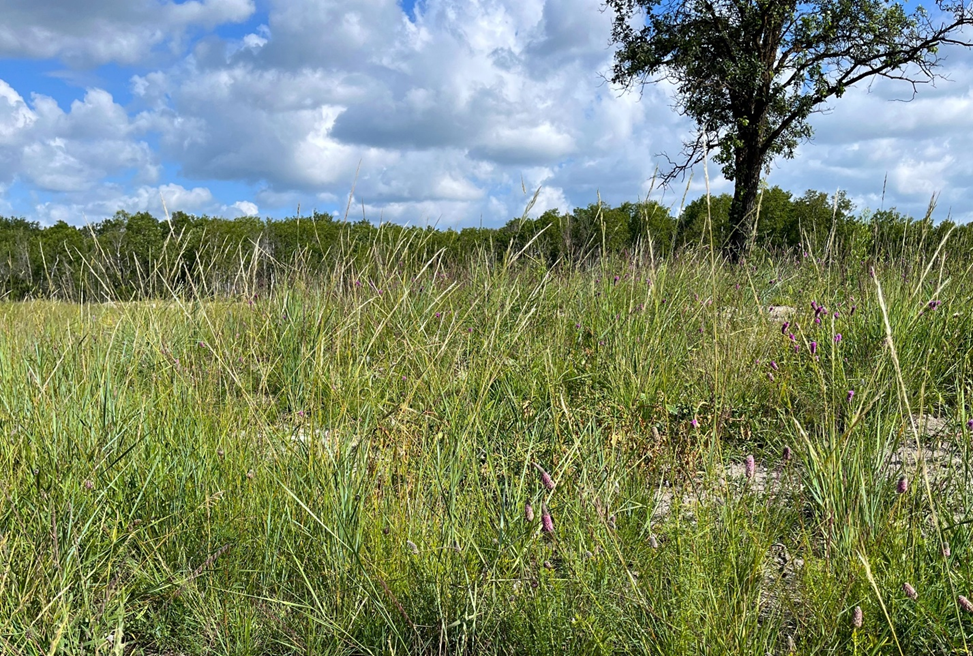Posted: February 7, 2024
How Converting Your Land to Native Prairie, Wetland, or Forest Can Help the Environment and your Neighbouring Farmer
The world is facing an unprecedented ecological crisis. Biodiversity is declining at an alarming rate, and climate change is exacerbating these issues. Surprisingly, one solution may be right in your own backyard: abandoned farmland. Converting old farmland into native habitat assists with mitigating climate change and increasing biodiversity. Returning abandoned farmland to native prairie, wetlands, or forest can have a huge benefit to the environment and your neighbouring farmers.
If you have an old farm field or are looking to retire your farmland, the East Interlake Watershed District (EIWD) can offer support and funding to ensure your land is restored to a functioning ecosystem.
Far too often we see abandoned farm fields left to ‘naturalize’ or fill in with invasive plants and noxious weeds. Unfortunately, these plants outcompete native species, leading to a decrease in the biodiversity of plants, insects, and birds. These noxious and invasive plants can spread onto neighbouring farmland which can cause increased herbicide application for farmers.
Luckily, there is a lot of opportunity to convert old farmland and abandoned fields into functioning ecosystems right here in the RM of St. Andrews. Converting old farmland back into native prairie, wetland, or forest can seem daunting at first, but the East Interlake Watershed District is here to help! The EIWD can provide landowners with advice, resources, appropriate consultants, and funding to assist with restoring habitat. If you’re wondering if your land may qualify do not hesitate to call us at (204) 642-7578.
Converting farmland back to its natural state provides multiple ecological goods and services including increased carbon sequestration, improved soil health, increased water storage capacity, improved water quality, increased drought and flood resiliency, and increased biodiversity. Once a field has been converted back into native habitat, the landowner may qualify for additional annual payments for conserving the valuable resource they established.
Converting old farmland into native prairies, wetlands, and forests is a crucial step towards restoring our planet’s health. It’s a win-win situation for both the environment and future generations. Let’s support and participate in these restoration efforts to ensure a sustainable future for all. Contact the EIWD today for more information.
 Image: Annually cropped farmland in the Wavey Watershed converted into native prairie in a cooperative project between landowners and the East Interlake Watershed District. This photo was taken one year after initial seeding.
Image: Annually cropped farmland in the Wavey Watershed converted into native prairie in a cooperative project between landowners and the East Interlake Watershed District. This photo was taken one year after initial seeding.
The East Interlake Watershed District (EIWD) is an organization of neighbouring municipalities, towns, and villages working together as a watershed community with the Province of Manitoba to promote the sustainable use and management of land and water resources within the East Interlake region of Manitoba.
Watershed districts are organized based on watershed boundaries. A watershed is simply the land that water flows across or through on its way to a common stream, river, or lake. A watershed can be very large (e.g. the Lake Winnipeg watershed drains 953 250 km2), or very small, such as a 20-acre watershed that drains to a pond. A small watershed that nests inside of a larger watershed is sometimes referred to as a subwatershed or subbasin.
The EIWD contains four subwatersheds of the Lake Winnipeg watershed; two which flow into the Red River, and two which flow into the south basin of Lake Winnipeg. These subwatersheds also delineate the boundaries of EIWD subdistricts. Each EIWD subdistrict maintains a board of representatives who make decisions about the land and water resources within their watershed.
The EIWD provides support to the R.M. of St. Andrews and its residents through various programs, support and funding opportunities. More information on the services provided can be found on their website.
East Interlake Watershed District
15 Jacobson Drive • Gimli, MB • R0C 1B0
(204) 642-7578